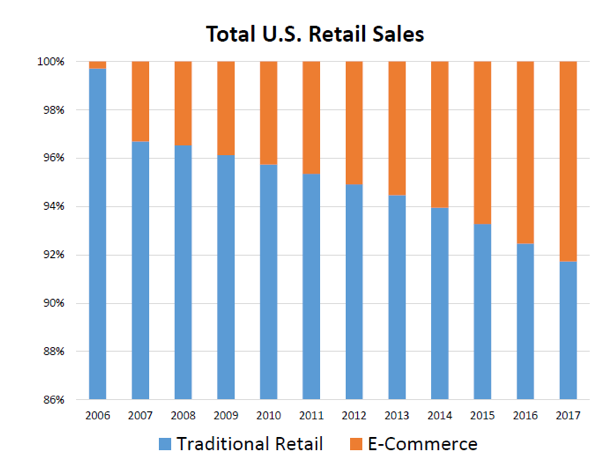
Barbara Ivanov, Director of the Urban Freight Lab, on a webinar through Eno about the final 50 feet: “Tickets are eaten as cost of business because there are no other alternatives. System must allow people to do their work without forcing them to engage in illegal behavior. Can meter, can ticket, but without actual building management change you haven’t affected behavior. Must work with managers, owners, and developers.”
First and foremost, we must discuss the increasing freight demand. With the growth of e-commerce and ride hailing changing urban parking needs. E-commerce has grown about 15% every year for last 11 years with sales totaling $453.5 billion in 2017 (see below). Simultaneously, we have ride hailing growth to match. In 2017 Lyft doubled its ridership and Uber is up to about 4 billion rides. These services create a negative feedback loop affecting curb demand, as parking problems are the top reason people use the service instead of driving. New York City placed a cap on FHVs, but it’s unlikely to have much of an impact. If this growth holds the volume of deliveries necessary will double in volume over the next 5 years.
Clearly, curb space is at a premium NOW and it is only going to become more important. So, what is the final 50 feet of the urban delivery system? It starts when a truck driver parks in a load/unload space:
- Includes delivery persons’ activities as they maneuver goods over curbs, along sidewalks and through intersections;
- Ends inside urban towers when they complete their deliveries.
There are two key goals to studying the final 50 feet:
- Reduce truck dwell time:
- Lower costs for delivery firms and lower costs for their customers.
- More efficient use of truck load/unload spaces creates more capacity without building additional spaces.
- Leave room for other vehicles to move.
- Reduce failed first deliveries:
- Improve urban online shoppers’ experiences and protect retailers’ brands.
- Lower traffic congestion in cities, as delivery trucks could make up to 15% fewer trips while still completing the same number of deliveries.
- Cut costs for the retail sector and logistics firms.
- Cut crime and provide a safer environment.
For Seattle, the three elements to the commercial vehicle load/unload space are: Curb-Alley-Loading Bays. Chicago, Detroit, and Minnesota are similar, but the East Coast Cities are not really set up this way, certainly not in the Tri-State area. Still the observations are still worth looking at. 87% of Seattle Center buildings rely on deliveries from curb and alley. Alley grids were built to provide access to backs of buildings-goods and services. 90% are only 1 lane wide. Because of this, trucks cannot pass by each other. Only 1 or 2 trucks at a time. Operationally this drives very limited capacity. Keep time slot as short as possible, many can be done in 15 mins.
After looking through the data there are three major strategies for trip reductions:
- Install common carrier Locker Systems (mini distribution nodes)- This can reduce urban congestion and dwell times, so trucks can deliver many packages at once. On average UPS delivery time was reduced by 78% time during a pilot program. Placing them at commuter train and bus stations is ideal.
- Require developers to provide loading bays in every new building. This is in conjunction with providing curb space for trucks NOT in lieu of.
- Use integrated technologies to manage the curb space in real time.
Ms. Ivanov’s ideas and research are a breath of fresh air in the current anti truck climate we find ourselves in New York City, though her research is Seattle based, she still offers wonderful analysis and best practices that should be applied by cities around the county to improve deliveries.